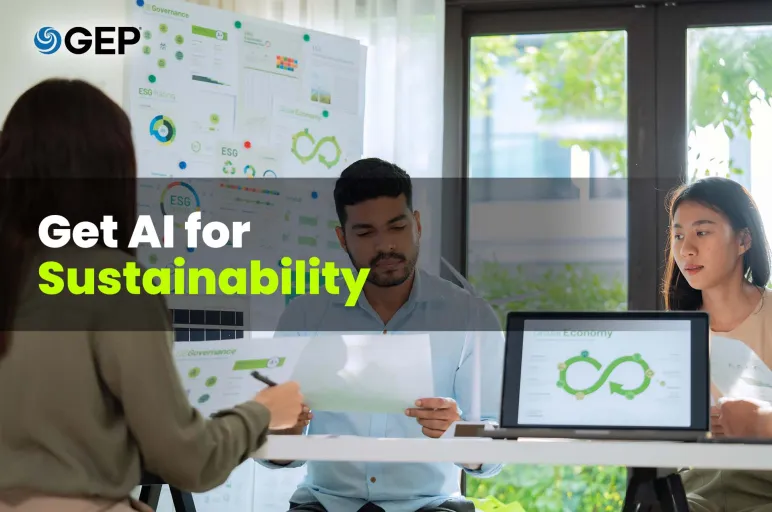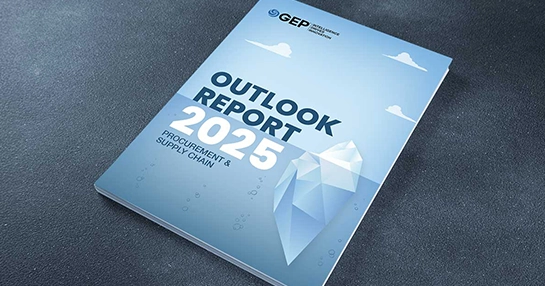
Can AI Help Procurement Build Sustainability?
- Procurement must lead the response to increasing sustainability regulations.
- With AI, procurement can align fragmented processes and track sustainability data across different systems.
- Procurement can also leverage AI to deal with sustainability reporting challenges.
October 07, 2025 | Procurement Strategy 3 minutes read
As sustainability becomes increasingly vital, the pressure is building on procurement to cut emissions, improve transparency, and meet regulatory requirements. The board is tired of watching sustainability initiatives come up short.
Can AI help procurement in these endeavors?
The short answer: Yes, it can.
With AI, procurement can identify inefficiencies, optimize sourcing, and track carbon data across supplier networks.
Yet the path forward is blocked by familiar obstacles: poor data quality, fragmented processes, and outdated systems.
Procurement must overcome these roadblocks to leveraging AI to meet sustainability targets.
Struggling with Sustainability Implementation?
Go Green by Leveraging AI-Powered Technology
3 Biggest Challenges to AI Adoption
AI can be an amazing partner for procurement teams looking to quickly scale their sustainable supply chains. But there are three obstacles to overcome:
- Fragmented data makes it difficult to enforce standards and unify reporting.
- Silos continue to exist as sustainability metrics are not embedded directly into procurement workflows.
- A lack of modern platforms and training impedes adoption.
Bad Data Leads to Bad Output
Even the most advanced AI models cannot work without clean and consistent data. Unfortunately, spotty emissions reporting, inconsistent supplier disclosures, and siloed data are the norm.
The biggest hurdle is Scope 3 emissions. Suppliers at multiple tiers either fail to report or provide estimates based on industry averages. These errors in reporting make the results suspect at best.
Procurement leaders cannot make sound decisions on sourcing strategies, carbon offsets, or green investments without trustworthy data. They must engage with suppliers regularly and integrate reporting systems. They should also invest in platforms that provide a consolidated view of environmental, social, and financial metrics.
Fragmented Processes Stall Pilots
Even with high-quality data, fragmented processes can hinder progress. Procurement, supply chain, operations, and sustainability teams often run parallel yet disconnected initiatives. With no clear owner, sustainability projects stall at the pilot stage.
To fully utilize AI-driven insights, leaders must embed sustainability into procurement workflows. They should include sustainability metrics in supplier selection, contract terms, and performance reviews. Likewise, contract clauses should mandate emissions reporting.
Supplier scorecards should assign weight to environmental and social performance. Payment processes should link to progress against sustainability milestones.
A connected AI-driven environment enables teams to turn insights into action.
Outdated Infrastructure Limits Adoption
Outdated infrastructure is another obstacle. Legacy ERP systems, static spreadsheets, and manual reporting were not built for the current volume or complexity of sustainability data.
However, even when advanced AI platforms are available, adoption is inconsistent. Teams often hesitate to trust outputs they do not fully understand. They may also lack the skills needed to configure models for sustainability use cases.
While AI-powered tools are critical, training and change management are equally important to success. Procurement professionals can’t sit on the sidelines. They must learn how to interpret AI outputs, question assumptions, and apply insights when negotiating with suppliers and compiling strategic plans.
Get Ready for Big Shifts in Sustainability Regulations
Here's a Quick Preparation Guide for Enterprises
The Path Forward is AI-Powered
AI has enormous potential. It can highlight suppliers with hidden emissions risks. It can identify the most sustainable logistics routes. It can model the impact of sourcing decisions on carbon footprints.
Importantly, it can also surface opportunities that manual analysis would miss, such as alternative suppliers with lower embodied emissions or unexpected energy efficiency gains.
To unlock this potential, enterprises must bridge the gap between vision and execution. That means:
- Establishing strong data governance to offer reliable inputs to AI models.
- Embedding sustainability into procurement processes to translate insights into measurable outcomes.
- Modernizing systems and upskilling teams to scale AI adoption across the enterprise.
Companies that tackle these challenges will not only meet their regulatory and ESG commitments; they will rise above the competition.
Customers, investors, and regulators are all monitoring how seriously enterprises address sustainability. Those that succeed will lower costs, reduce risks, and strengthen supplier partnerships while accelerating progress toward net-zero goals.
View AI as a Sustainability Partner
AI cannot fully replace the human-centered tasks of gathering accurate data, redesigning processes, and building capabilities.
What AI can do is help procurement leaders navigate the complex trade-offs of cost, risk, and sustainability.
The winners will treat AI as a strategic enabler, not a plug-and-play tool. By tackling the roadblocks head-on, they can turn AI into a powerful engine for greener, smarter supply chains.
Also Read: Sustainable Procurement



